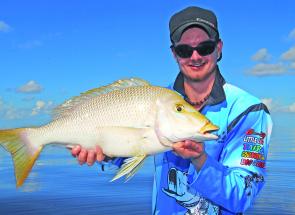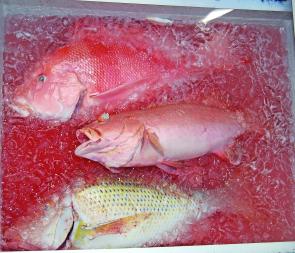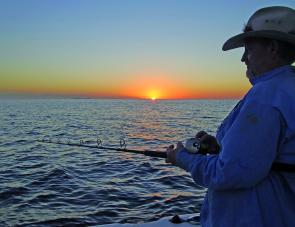When I’m fishing creeks, timber-filled dams, rocky islands and reefs I find myself faced with the all-consuming question of where to target the fish? There is simply so much structure that ‘look-the-goods’ that it boggles the mind. Because of this, it was somewhat refreshing to experience the opposite for a change.
Off the coast of my hometown of Mackay there is a plethora of inshore and offshore islands that is set against nothing but open, deepwater for miles, until you come to lines of towering coral that make up the Barrier Reef. These miles of nothingness are actually quite a refreshing fishing option, which not only produces some of the best quality fish in the world, but also provide consistent numbers of fish.
This area is known as the Shipping Channel to most and the fishing grounds to some of the older generation. It has been my goal of late to suss out this quirky ‘species band’ and, after a few trips with the specialists aboard Reefari Charters and a few other maverick local anglers, I think I might be getting somewhere.
This is probably the area’s greatest drawcard. It’s all about finding needles in haystacks, and before you turn up your nose I’ve seen 12kg red emperor pulled off miniscule spikes on a depth sounder. These pin head sized marks are often as insignificant as an ant on Wall Street, yet it is these tiny little patches of rubble, rock or even rising sand that draw bait and predators like magnets.
As I mentioned, it’s refreshing to be able to take the guesswork out of looking for structure. The rule of thumb here is simple – if it’s not flat, it’ll probably hold fish!
Before you get the idea that this type of fishing is easy, let me clarify a few points. Yes, the structure often holds schools of trophy captures. Yes, once you’ve found a few of these deepwater structures you can almost guarantee yourself a reasonably full icebox, and yes, these are not small fish. However, structure is not easy to find, it is difficult to fish effectively and these fish take a lot of stopping in the deep!
I read an article by well-know writer John Mondora that was called Never Take Your Eyes Off The Sounder. John is right on the money, and as yet I’ve never met a good Shipping Channel skipper that leaves the depth sounder while travelling – they stick to it like a tongue on an icy pole! Most of them will actually travel with a finger resting on the ‘mark’ button of their GPS, so that the minute they see a change of bottom it’s saved.
Sounder power and scroll speed are essential for this type of activity. I’d recommend a colour sounder with an output of around 3000-4000W and a high ping speed. You need to be able to get a clear bottom picture at speed, have a realistic response time from your transducer to your screen and have minimum prop-wash and static. A through-hull transducer can also be effective.
Once you’ve found a reasonable mark, act quickly and backtrack along your trail or prop-wash until you locate the structure. From there, do some rough grid-work of the area; just in case there’s anything more substantial in the immediate vicinity.
Often these patches can be spread out, with a coverage of anywhere between a house block and a football field. Once you’ve establish some points of interest (the ‘?’ feature of the GPS is handy for this), start drifting so that your initial drifts take you in a series of parallel tracks over the marks. I’m a fan of the snail-trail feature on the GPS for this, as it gives you a clear idea of the ground covered. If a point of interest fires, make it a proper mark and name it with a species or descriptive characteristic. Any sizable fish hooked away from the marks should also be recorded with a mark and explored further.
These marks hold a variety of species from red fish like nannygai, fingermark, snapper and red emperor to sweetlip and coral trout. So don’t make the common mistake of running a single depth with your rigs. For example, we have found that a simple running sinker rig with a hook on the bottom works better for trout than a paternoster. The paternoster is, however, very effective for working baits off or near the bottom. So it is quite common to hook your red fish on the top hook and sweetlip on the bottom, so use a range of hooks. I like a 10/0 at the top and an 8/0 on the bottom.
Keep watching that sounder, as it’s not uncommon to see a misty green layer around 10-20m off the bottom. This phenomenon is often found to be schooling nannygai and even snapper at times so don’t be afraid to lift your baits up well off the bottom.
Once you do find a patch of sought-after red fish, take your time and think back over all the things you’ve learnt while reef fishing…and then forget everything! It’s a whole new ball game this deepwater drifting.
Firstly, downsize your line’s diameter to maximise sensitivity and minimise current drag. Braids of between 30lb and 65lb are usually the way to go, but keep you leader at the 100lb mark.
Secondly, the structure is limited here so there’s no need to hit the fish with brute strength. Back your drag off slightly, use a faster tapered rod and allow your fish to run. The reasoning behind this is most red fish have soft delicate mouths that are incredibly easy to pull hooks on. If you go overly hard on them it’s a common occurrence to have a fish beaten, only for the hook to inexplicably fall out half way up.
I’m not condoning wanton fish killing, but I must admit that when you go the extra miles and burn the extra fuel to push out to one of the further ‘species bands’ it’s nice to be able to bring home some quality fish. Nothing puts butterflies in the stomach and a bruise on the abdomen like a big red or nanny and nothing matches the sheer craziness of multiple hooks ups on these trophy fish.
Once you’ve experience the absolute madness of seeing a tiny ‘pin head’ mark stacked up on the sounder with arches thicker than the roof of the Opera House you’ll never forget it. In fact I know that the crew of Reefari Charters name their Shipping Channel marks to describe each one’s fishing attributes. They’re called Mayhem, Carnage, Slaughter, Insane and Chaos. Get the picture?
Facts
Author’s Tips
• It’s a fair hike, so plan your fuel consumption and make up an ice slurry to keep fish fresh;
• The new jigging blanks designed by most rod manufacturers have an ideal taper for this area;
• Use big baits, like whole squid, slab baits with tails attached, and fish wings with fins attached;
• Invest in a sea anchor to slow down your drift; and,
• Big soft plastics (100mm and longer) are lethal.

A deep water spangled emperor. What a day!

Add salt to your ice to create a slurry for those long runs to the Shipping Channel.

Fishing the Shipping Channel on dusk is both beautiful and chaotic.

Fishing with Reefari Charters over their ‘Chaos’ mark produced a dozen of these colourful captures.

Grassy lipper are a welcome by-catch. You can see why the older generation call the Shipping Channel the Fishing Grounds!

Jason Hoton with a pair of quality Shipping Channel snodgers.




